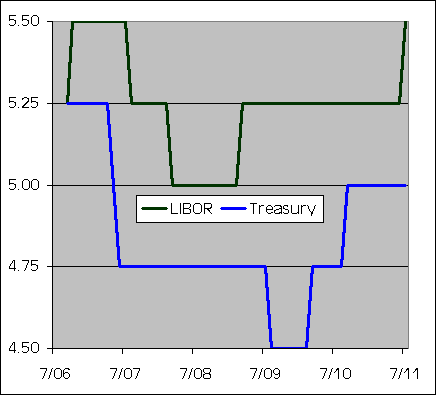Several recent posts have been about the forward curve (here, and here) which is simply using the shape of the yield curve to indicate what the market has priced in for future short-term rates. There have been some misconceptions about the analysis, which I'd like to address.
First, the forward curve is simply a reflection of market opinion. If you want to make a 6-month investment, you can either buy a 6-month bond or two consecutive 3-month bonds. You know what the 6-month rate is, so you have to consider where you think the 3-month rate will be 3-months from now. You'll only buy the 3-month if you think the compounded rate of today's 3-month plus the forward 3-month will yield more than today's 6-month.
Since bond buyers are making these kinds of decisions all the time, we assume that the market is efficient, and therefore the 6-month rate is equal to today's 3-month compounded with the forward 3-month. This is why academics say the forward curve is an "unbiased predictor of future rates."
Unbiased, sure, but how accurate? Well, on the very short-term part of the yield curve, its OK. But for longer-term rates, its terrible. Why? Because if the forward curve encompasses all current opinions about the market. But market participants have varied opinions, and so some will be right and some will be wrong. For example, right now there are people calling for a recession in 2007, but others calling for an inflation spike. These are two possible paths for the economy and hence rates. These are two bets currently priced into the market. But they won't both be right. Rates will actually move on whichever turns out to be right.
Its exactly like stocks. Efficient markets theory says that the current stock price encompasses all known information about a stock. That would imply that the price wouldn't chance over time. But of course, it does, because new information is always emerging.
Anyway, I received a comment that my forward curve analysis should be based on LIBOR swaps not Treasury rates. That's debatable. O/N LIBOR and Fed Funds are normally right on top of each other, whereas there is normally a negative spread between T-Bills and Fed Funds (about 8bps based on O/N rates). Point for LIBOR. On the other hand, there is a special bid for T-Bills from government money market funds which doesn't exist for 2-5 year notes. Also, the LIBOR curve is almost always steeper than the Treasury curve. So the difference between the 2-year and 5-year swap rate may have less to do with Fed activity and more to do with this natural slope difference. I'd say both analysis have merit, so I'm going to show both, except I'm going to subtract 8bps from the FF rate and use that as the basis for the Treasury analysis.
Tuesday, August 22, 2006
Thoughts on the Forward Curve
Subscribe to:
Post Comments (Atom)



No comments:
Post a Comment